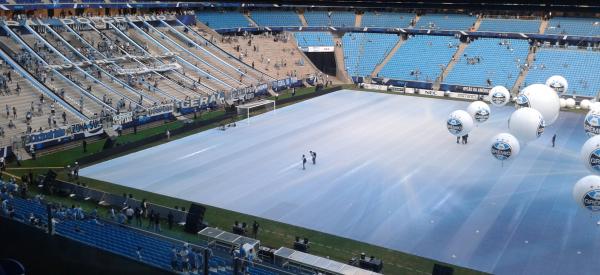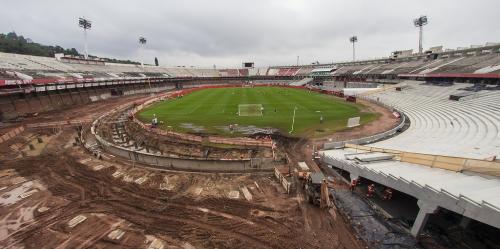
The 2012 Brazilian Séria A season has just finished, but when the new season starts in May 2013, much will have changed. The reason for this is that the largest country of South America will be swept by a series of stadium openings in the next few months, and the Grêmio Arena led the way on Saturday.
The Grêmio Arena is the new home of, not unsurprisingly, football club Grêmio, who are from Porto Alegre in the south of Brazil. It is a modern arena in the style of those we have recently seen open in Europe, such as Grande Stade Métropole Lille and the Friends Arena, with a total of 60,000 seats divided over two large and two small tiers. It even has a terrace behind one of the goals, which is not that common in Brazil.
The opening was celebrated with a show of music, dance, figures, light and fireworks, and concluded with a friendly match between Grêmio and German side HSV, which was won 2-1 by the home team.
You can watch the whole two-hour show below (though no football), or just the first minute to get an idea:
Some photos of the opening can be found here on Grêmio’s Flickr account.
The new arena complies with all requirements that are expected of a stadium these days, but will not be part of the upcoming 2014 World Cup. Instead, the honour goes to Estádio Beira-Rio, which is home to Grêmio’s rivals Internacional and is currently undergoing redevelopments that will only be completed in late 2013.
The fact that Beira-Rio has been chosen over the Grêmio Arena has been a source of frustration for most Grêmio fans. After all, the Grêmio Arena will be able to hold 5,000 more seats and offers superior facilities and sightlines as it has been newly built instead of redeveloped. This frustration got only worse when it turned out that the redevelopment of Beira-Rio was faced with recurring delays, while construction of the Grêmio Arena progressed smoothly.
Fans have blamed this on favouritism of important politicians that support Internacional, while others have argued that Internacional presented misleading plans that showed a grand project that could never get realised. Of course, it may also have been that decision makers did not trust Grêmio to get the project done, after all, various clubs presented new stadium plans in the past, but few got realised.
In the end, one set of fans was always going to be disappointed, and once it became clear that Grêmio was to prove everyone wrong while Internacional kept struggling with their project, it was already too embarrassing and politically sensitive for the organising committee and politicians to change the venue.
The Grêmio Arena will therefore likely only serve as a training accommodation during the World Cup, though may also form part of a plan B in case one of the other venues does not get finished in time.

The opening of the Grêmio Arena will get followed by those of about ten more stadiums in the year to come. Actually, earlier this year Estádio Independência was technically already the first new stadium in Brazil to open, but it is a much more modest affair with just over 20,000 seats.
Next in line are now Fortaleza’s Castelão and Belo Horizonte’s Mineirão. The former is expected to open in January (possibly with the Clássico Fortaleza vs Ceará), while Mineirão’s opening is scheduled for the 3rd of February 2013. Again, the occasion will be a Clássico, this time between Atlético Mineiro and Cruzeiro, who will both then permanently return to their long-time home.
Other Séria A clubs that will move into a new or redeveloped home before the start of the season are Recife‘s Náutico, Bahia and Vítoria – both from Bahia -, and Rio’s Flamengo and Fluminense, who will return to Maracanã.
Atlético Paranaense will likely have to wait a few more months before they can move back to the Arena da Baixada, while the planned new home of Corinthians in São Paulo will not be finished before the end of the 2013 season. Relegated Palmeiras can finally stop groundhopping and move into a new stadium in 2013, but just like the Grêmio Arena it won’t get to host World Cup matches.
These are therefore exciting times for Brazilian football, but also times that pose challenges. Attendances, for example, were abysmal during the 2012 Série A season, with clubs only averaging 13,196 spectators per match. This was obviously not helped by the many clubs without a proper home, but we recently also found out that Brazil has the highest ticket prices in the world if adjusted for wages, which was even before any new arena opened.
It will therefore be interesting to see if these new stadiums will boost attendances, how ticket prices will develop, and whether these will still be affordable for the common fan once clubs have moved to a modern home.
The cheapest tickets for the opening of the Grêmio Arena went for US$ 50.00, not a good omen, but then this included a live show and concert of the Blue Man Group. Still, the arena was completely packed for its opening.
(Photo credits: Grêmio Arena – Flickr user Mílton Jung, Estádio Beira-Rio – Flickr user copagov)